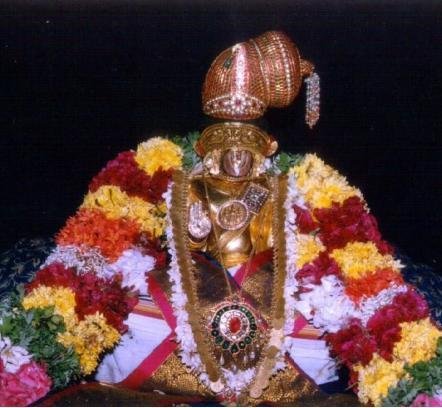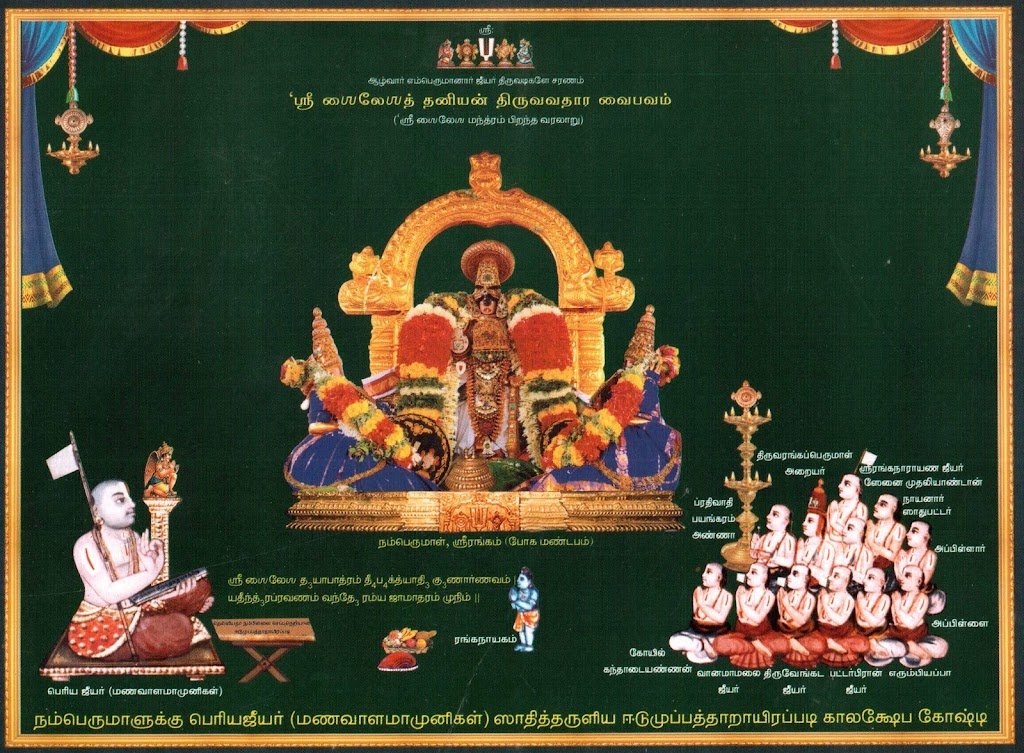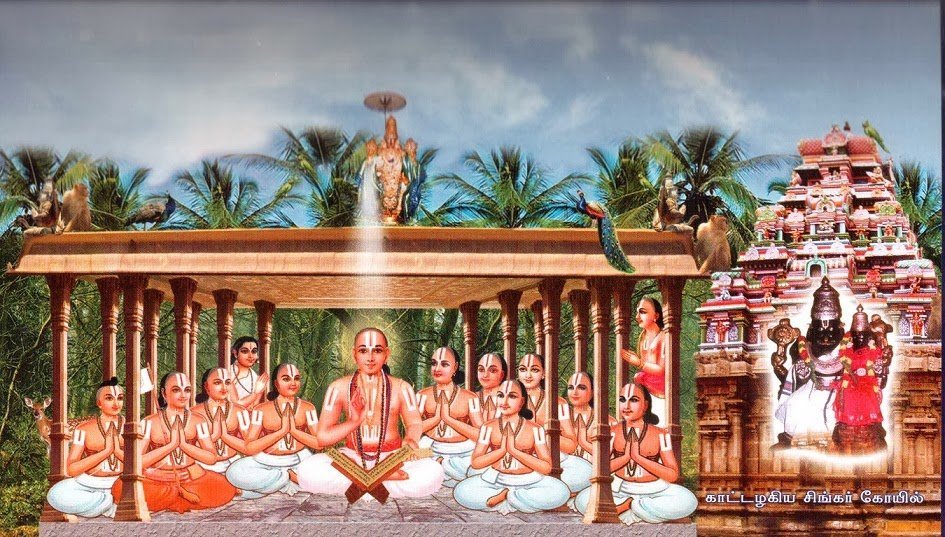and his divine work srI vachana bhUshaNam through the most
beautiful vyAkyAna avathArikai (introduction to commentary) of maNavALa mAmunigaL
for this master piece. We have already seen the brief introduction to this glorious prabhandham and its thanians at https://granthams.koyil.org/2013/11/aippasi-anubhavam-pillai-lokacharyar-srivachana-bhushanam-thanians/. We have also seen the first part of mAmunigaL‘s avathArikai (introduction) to this glorious prabhandham at https://granthams.koyil.org/2013/11/aippasi-anubhavam-pillai-lokacharyar-sri-vachana-bhushanam-1/ and the second part at https://granthams.koyil.org/2013/11/aippasi-anubhavam-pillai-lokacharyar-sri-vachana-bhushanam-2/.
Let us continue with the third and concluding part of the avathArikai (introduction). In this section of the introduction, mAmunigaL explains that this srI vachana bhUshaNam is explaining dhvaya mahA manthram in detail as it is done in thiruvAimozhi.

- In the first 3 centums (1 – 3), the second part of dhvayam (upEyam – goal) is explained in detail.
- In the next 3 centums (4 – 6), the first part of dhvayam (upAyam – means) is explained in detail.
- In the next 4 centums, the following principles are explained in detail:
-
- the auspicious qualities of bhagavAn which are required in him to bless everyone
-
- nammAzhwAr‘s total detachment towards AthmA (self) and that which are related to AthmA such as body, senses, etc.
-
- the eternal relationship between himself (nammAzhwAr) and emperumAn
-
- nammAzhwAr recollecting the accomplishment of ultimate goal

Considering the 6 prakaraNams (sections) classification:
- First part of dhvayam is explained in the first 3 prakaraNams:
-
- First srI mAhAlakshmi‘s purushakAram (advocacy/recommendation) is explained
-
- bhagavAn as the upAyam (means) is explained
-
- The nishtai (state) of the ones who accept bhagavAn as upAyam (goal)
- Second part of dhvayam is explained while explaining the desirable state of the ones who want to fully engage in bhagavath kainkaryam only.
- In the remaining 3 prakaraNams,
- 4th prakaraNam explains the sishya’s attitude and servitude towards AchArya who explains the dhvaya mahA manthram
- 5th prakaraNam explains bhagavAn‘s nirhEthuka krupai (causeless mercy) which is the cause of the sishya’s mahA viswAsam (total dependence)
- 6th prakaraNam explains the ultimate state of the principles explained in two parts of the dhvaya mahA manthram (upAyam and upEyam) – that is total dependence on AchAryan.
“prapadhyE” in first sentence of dhvayam reflects the act of accepting bhagavAn as the means and this implicitly means that other upAyams such karma, gyAna, bhakthi yOgams, etc are given up fully. prapanna dhinacharya (daily routine, attitude, behaviour of a prapanna) is meant for such persons who have performed prapathi. And a true AchArya means the one who instructs/explains dhvaya mahA manthram. Thus, from all of the above, it can be understood that in the 9 prakaraNam classification also, thiruvAimozhi (dhvaya mahA manthram’s explanation) and srI vachana bhUshaNam explain the same principles.
Further, this prabhandham which mainly explains the dhvaya mahA manthram in detail, also contains the principles that are explained in thirumanthram and charama slOkam. Let us see that now:First thirumanthram explanation is highlighted.
- From (sUthram 73) “ahamarththaththukku” (அஹமர்த்தத்துக்கு) upto (sUthram 77) “adiyAnenRiRE” (அடியானென்றிறே) and as said in (sUthram 111) “svarUpa prayukthamAna dhAsyamiRE pradhAnam” (ஸ்வரூப ப்ரயுக்தமான தாஸ்யமிறே ப்ரதானம்), “praNavam” is explained.
- From (sUthram 71) “svayathna nivruththi” (ஸ்வயத்ந நிவ்ருத்தி) and from (sUthram 180) “thannaith thAnE mudikkaiyAvathu” (தன்னைத் தானே முடிக்கையாவது) upto the sUthram before (sUthram 243) “ippadi sarva prakAraththAlum” (இப்படி ஸர்வ ப்ரகாரத்தாலும்), “nama:” is explained.
- From (sUthram 72) “paraprayOjana pravruththi” (பரப்ரயோஜந ப்ரவ்ருத்தி) and from (sUthram 80) “upEyaththukku iLaiya perumALaiyum” (உபேயத்துக்கு இளைய பெருமாளையும்) and from (sUthram 281) “kainkaryam thAn bhakthi mUlam allAtha pOthu” (கைங்கர்யம் தான் பக்தி மூலம் அல்லாத போது), “nArAyaNAya” is explained.
- From (sUthram 43) “agyAnaththAlE” (அஜ்ஞானத்தாலே) and from (sUthram 115) “prApakAnthara parithyAgaththukkum” (ப்ராபகாந்தர பரித்யாகத்துக்கும்) explains giving up all other upAyams and the method to give it up. This explains “sarvadharmAn parithyajya“.
- From (sUthram 55) “ithu thanakku svarUpam” (இது தனக்கு ஸ்வரூபம்) and from (sUthram 66) “prApthikku upAyam avan ninaivu” (ப்ராப்திக்கு உபாயம் அவன் நினைவு) explains that bhagavAn is the only refuge and means. This explains “mAmEkam sharaNam“.
- From (sUthram 134) “prapaththi upAyaththukku” (ப்ரபத்தி உபாயத்துக்கு) explains the special nature of the act of surrender. This explains “vraja“.
- From (sUthram 143) “avanivanai” (அவனிவனை) upto (sUthram 148) “svAthanthriyaththAlE varum pArathanthriyam prabalam” (ஸ்வாதந்த்ரியத்தாலே வரும் பாரதந்த்ரியம் ப்ரபலம்) explains that bhagavAn is supremely independent and him easily pardoning all sins of the surrendered jIvAthmA. This explains “aham thvA sarva pAbEpyO mOkshayishyAmi“.
- (sUthram 402) “krupA palamum anubaviththE aRavENum” (க்ருபா பலமும் அநுபவித்தே அறவேணும்) explains that bhagavAn‘s mercy is guaranteed to bestow the ultimate goal and the jIvAthmA need not worry about. This explains “mA sucha:“.
தீதில் திருமலையாழ்வார் செழுங்குரவை மணவாளர்
ஓதரிய புகழ்த் திருநாவுடைய பிரான் தாதருடன்
போத மணவாள முனி பொன்னடிகள் போற்றுவனே

Simple translation: I glorify the lotus feet of the most knowlegeable maNavALa mAmunigaL along with the blemishless piLLai lOkAchArayar, kUra kulOthuma dhAsar, the defectless thirumalai AzhwAr (thiruvAimozhi piLLai), azhagiya maNavALa perumAL piLLai (mAmunigaL’s grand father) from kuravai clan, the boundlessly famous thirunAvIrudaiya pirAn thAtharaNNar (mAmunigaL’s father).
வாழி முடும்பை என்னும் மாநகரம்
வாழி மனம் சூழ்ந்த பேரின்பம் மிகு நல்லார்
இனம் சூழ்ந்து இருக்கும் இருப்பு

Simple translation: Hail piLLai lOkAchAryar! Hail his glorious clan! Hail the great city mudumbai (native town of his clan)! Hail that blissful assembly of piLLai lOkAchAryar who is surrounded by the most pious devotees.
ஏதும் மறவாத எம்பெருமான்
நீதி வழுவாச் சிறுநல்லூர் மாமறையோன் பாதம் தொழுவார்க்கு
வாரா துயர்
archived in https://granthams.koyil.org, also visit https://granthams.koyil.org, https://acharyas.koyil.org, https://sriperumbuthur.blogspot.comReferences: vidhwAn srImAn purushOthama nAidu’s thamizh translation for srIvachana bhUshaNam

Brilliant writing
In Hindi: https://granthams.koyil.org/2016/01/04/thula-anubhavam-pillai-lokacharyar-sri-vachana-bhushanam-3-hindi/
In thamizh – https://granthams.koyil.org/2017/12/23/aippasi-anubhavam-pillai-lokacharyar-sri-vachana-bhushanam-3-tamil/